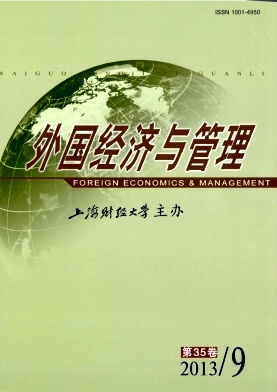国外全球蜂鸣研究进展探析
外国经济与管理 2013 年 第 35 卷第 09 期, 页码:52 - 60
摘要
参考文献
摘要
2004年,Maskell率先提出"全球蜂鸣"概念,并将其定义为"在一个特殊的体系内所形成的知识与技术信息交流平台",如国际贸易展销会。近年来,全球蜂鸣已突破了其仅限于经济、管理领域的服务范围,开始作为一个特殊的信息交流平台服务于经济、管理、政治、社会和文化等多个领域,从而受到国外学者的广泛关注。本文在收集和整理国外相关文献的基础上,介绍了全球蜂鸣的含义和表现形式,分析了全球蜂鸣的主要特征,阐述了全球蜂鸣的作用,并指出了国外该领域研究所存在的缺陷与空白,进而对未来研究方向及趋势进行了探讨。
[1]Asheim B T and Gertler M S.The geography of innovation:Regional innovation systems[A].Fagerberg J,Mowery D C and Nelson R R(Eds.).The oxford handbook of innovation[C].Oxford:Oxford University Press,2005:291-317.
[2]Bathelt H,Malmberg A and Maskell P.Clusters and knowledge:Local buzz,global pipelines and the process of knowledge creation[J].Regional Studies,2004,28(6):31-56.
[3]Bathelt H and Schuldt N.Between luminaires and meat grinders:International trade fairs as temporary clusters[J].Regional Studies,2008,42(2):853-868.
[4]Bathelt H and Schuldt N.Temporary face-to-face contact and the ecologies of global and virtual buzz[J].Spaces,2008,24(6):114-162.
[5]Bathelt H and Schuldt N.International trade fairs and global buzz,part I:Ecology of global buzz[J].European Planning Studies,2010,12(8):120-139.
[6]Boissevain J.Friends of friends:Networks,manipulators and coalitions[M].Oxford:Blackwell,1974.
[7]Borghini S,Golfetto F and Rinallo D.Ongoing search among industrial buyers[J].Journal of Business Research,2006,59(8):1151-1159.
[8]Brown J S and Duguid P.Balancing act:How to capture knowledge without killing it[J].Harvard Business Review,2000,78(5):73-80.
[9]Chizzoli C.Technological versus market-based competences in a market created by innovation:Empirical evidence from Italian business-to-business e-marketplaces[M].Mimeo Milan:Business Management and Administration,2003.
[10]Dicken P.Global shift:Reshaping the global economic map in the 21st century[M].London:Sage,2003.
[11]Entwistle J and Rocamora A.The field of fashion materialized:A study of London Fashion Week[J].Sociology,2006,40(3):735-751.
[12]Goffman E.Behavior in public places[M].New York:The Free Press,1969.
[13]Grabher G,Ibert O and Flohr S.The neglected king:The customer in the new knowledge ecology of innovation[J].Economic Geography,2008,84(1):253-280.
[14]Harvey D.The condition of postmodernity:An enquiry into the origins of cultural change[M].Cambridge,MA:Blackwell,1990.
[15]Hildreth P M.Going virtual:Distributed communities of practice[M].Hershey,PA:Idea Group Publishing,2004.
[16]Ibert O.Towards a geography of knowledge creation:The ambivalences between knowledge as an object and knowing in practice[J].Regional Studies,2007,41(2):103-114.
[17]Jansson J and Power D.Cyclical clusters in global circuits:Overlapping spaces and furniture industry trade fairs[J].Economic Geography,2008,84(7):423-448.
[18]Maskell P,Bathelt H and Malmberg A.Temporary clusters and knowledge creation:The effects of international trade fairs,conventions and other professional gatherings[J].Spaces,2004,85(4):73-105.
[19]Massey D.Geographies of responsibility[J].Geografiska Annaler,2004,86(1):5-18.
[20]Moodysson J.Principles and practices of knowledge creation:On the organization of buzz and pipelines in life science communities[J].Economic Geography,2008,84(4):449-469.
[21]Moriset B and Malecki E J.Organization vs.space:The paradoxical geographies of the digital economy[R].The Annual Meeting of the Association of American Geographers,Boston,2008.
[22]Portes A.Transnational entrepreneurs:An alternative form of immigrant economic adaptation[J].American Sociological Review,2002,67(9):278-298.
[23]Pruser S.Messemarketing:Einnetzwer-korientierter ansatz[M].Wiesbaden:Deutscher Universitats-Verlag,1997.
[24]Rosson P J and Seringhaus F H R.Visitor and exhibitor interaction at industrial trade fairs[J].Journal of Business Research,1995,32(4):81-90.
[25]Schlink G.The diffusion of creative ideas:Why does geographical proximity matter[J].Proximity Economics Congress,2006,51(7):54-72.
[26]Skov L.The role of trade fairs in the global fashion business[J].Current Sociology,2006,54(39):764-783.
[27]Thrift N.Performing cultures in the new economy[J].Annals of the Association of American Geographers,2000,90(4):674-692.
[28]Uzzi B.Social structure and competition in interfirm networks:The paradox of embeddedness[J].Administrative Science Quarterly,1997,42(11):35-67.
[29]Walther J B,Loh T and Granka L.Let me count the ways:The interchange of verbal and nonverbal cues in computer-mediated and face-to-face affinity[J].Journal of Language and Social Psychology,2005,24(1):36-65.
[30]Wickham J and Vecchi A.Local firms and global reach:Business air travel and the Irish software cluster[J].European Planning Studies,2008,16(11):693-710.
[2]Bathelt H,Malmberg A and Maskell P.Clusters and knowledge:Local buzz,global pipelines and the process of knowledge creation[J].Regional Studies,2004,28(6):31-56.
[3]Bathelt H and Schuldt N.Between luminaires and meat grinders:International trade fairs as temporary clusters[J].Regional Studies,2008,42(2):853-868.
[4]Bathelt H and Schuldt N.Temporary face-to-face contact and the ecologies of global and virtual buzz[J].Spaces,2008,24(6):114-162.
[5]Bathelt H and Schuldt N.International trade fairs and global buzz,part I:Ecology of global buzz[J].European Planning Studies,2010,12(8):120-139.
[6]Boissevain J.Friends of friends:Networks,manipulators and coalitions[M].Oxford:Blackwell,1974.
[7]Borghini S,Golfetto F and Rinallo D.Ongoing search among industrial buyers[J].Journal of Business Research,2006,59(8):1151-1159.
[8]Brown J S and Duguid P.Balancing act:How to capture knowledge without killing it[J].Harvard Business Review,2000,78(5):73-80.
[9]Chizzoli C.Technological versus market-based competences in a market created by innovation:Empirical evidence from Italian business-to-business e-marketplaces[M].Mimeo Milan:Business Management and Administration,2003.
[10]Dicken P.Global shift:Reshaping the global economic map in the 21st century[M].London:Sage,2003.
[11]Entwistle J and Rocamora A.The field of fashion materialized:A study of London Fashion Week[J].Sociology,2006,40(3):735-751.
[12]Goffman E.Behavior in public places[M].New York:The Free Press,1969.
[13]Grabher G,Ibert O and Flohr S.The neglected king:The customer in the new knowledge ecology of innovation[J].Economic Geography,2008,84(1):253-280.
[14]Harvey D.The condition of postmodernity:An enquiry into the origins of cultural change[M].Cambridge,MA:Blackwell,1990.
[15]Hildreth P M.Going virtual:Distributed communities of practice[M].Hershey,PA:Idea Group Publishing,2004.
[16]Ibert O.Towards a geography of knowledge creation:The ambivalences between knowledge as an object and knowing in practice[J].Regional Studies,2007,41(2):103-114.
[17]Jansson J and Power D.Cyclical clusters in global circuits:Overlapping spaces and furniture industry trade fairs[J].Economic Geography,2008,84(7):423-448.
[18]Maskell P,Bathelt H and Malmberg A.Temporary clusters and knowledge creation:The effects of international trade fairs,conventions and other professional gatherings[J].Spaces,2004,85(4):73-105.
[19]Massey D.Geographies of responsibility[J].Geografiska Annaler,2004,86(1):5-18.
[20]Moodysson J.Principles and practices of knowledge creation:On the organization of buzz and pipelines in life science communities[J].Economic Geography,2008,84(4):449-469.
[21]Moriset B and Malecki E J.Organization vs.space:The paradoxical geographies of the digital economy[R].The Annual Meeting of the Association of American Geographers,Boston,2008.
[22]Portes A.Transnational entrepreneurs:An alternative form of immigrant economic adaptation[J].American Sociological Review,2002,67(9):278-298.
[23]Pruser S.Messemarketing:Einnetzwer-korientierter ansatz[M].Wiesbaden:Deutscher Universitats-Verlag,1997.
[24]Rosson P J and Seringhaus F H R.Visitor and exhibitor interaction at industrial trade fairs[J].Journal of Business Research,1995,32(4):81-90.
[25]Schlink G.The diffusion of creative ideas:Why does geographical proximity matter[J].Proximity Economics Congress,2006,51(7):54-72.
[26]Skov L.The role of trade fairs in the global fashion business[J].Current Sociology,2006,54(39):764-783.
[27]Thrift N.Performing cultures in the new economy[J].Annals of the Association of American Geographers,2000,90(4):674-692.
[28]Uzzi B.Social structure and competition in interfirm networks:The paradox of embeddedness[J].Administrative Science Quarterly,1997,42(11):35-67.
[29]Walther J B,Loh T and Granka L.Let me count the ways:The interchange of verbal and nonverbal cues in computer-mediated and face-to-face affinity[J].Journal of Language and Social Psychology,2005,24(1):36-65.
[30]Wickham J and Vecchi A.Local firms and global reach:Business air travel and the Irish software cluster[J].European Planning Studies,2008,16(11):693-710.
引用本文
肖龙, 刘晓霞, 李立. 国外全球蜂鸣研究进展探析[J]. 外国经济与管理, 2013, 35(9): 52–60.
导出参考文献,格式为:
上一篇:悲伤消费效应研究综述





 7278
7278  211
211

